
Sage: 7 ideas for successful companion planting
Discover which plants to pair them with!
Contents
Sages are superb plants that offer colourful flowering and often aromatic foliage. There are nearly 1,000 species, plus numerous horticultural varieties. They produce delicate flowers in a range of colours: blue, violet, mauve, white, pink, red, yellow… Their foliage is also decorative, and some varieties have variegated leaves. Sages are robust plants and fairly easy to grow. Most prefer full sun and free-draining soil. They dislike winter damp. They require little maintenance but appreciate pruning in late winter. In the garden, they are fairly easy to combine, pairing well with other foliage and flowering plants. You should have no trouble finding room for them in your garden! Discover our ideas and inspiration for combining them to create stunning displays!
In a naturalistic, wild garden
Sage fits easily into a naturalistic garden. Choose airy-flowering species, such as Salvia pratensis, which offers lovely blue flowers borne on erect stems. It grows wild in France, in meadows and open habitats. It will bring a truly rustic feel to your garden! You can also choose Salvia verticillata, which has smaller violet-blue flowers. Combine salvias with other flowering plants such as astrantias, bellflowers, hardy geraniums, achilleas, Buenos Aires verbena… Prefer perennials with small flowers and long, airy flower stems that sway in the wind. Don’t forget to add ornamental grasses, such as Stipa tenuifolia, Pennisetum, Briza media or Miscanthus…!
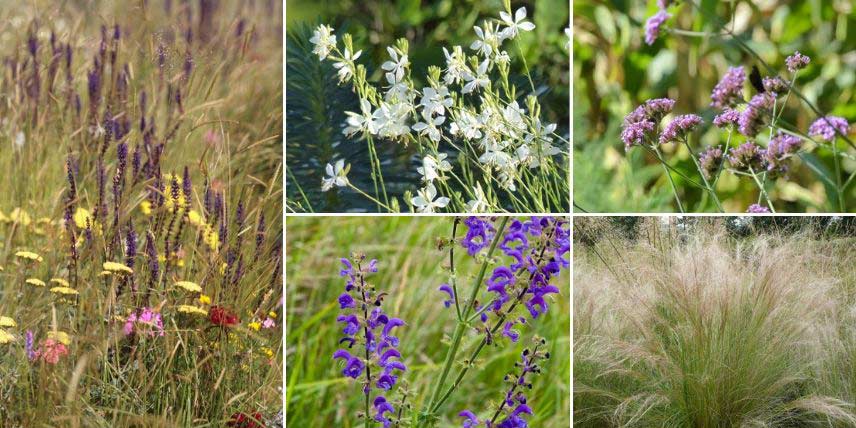
Salvia nemorosa ‘Caradonna’ and Achillea / Gaura lindheimeri ‘Snowbird’ / Verbena bonariensis / Salvia pratensis (photo Olivier Pichard) / Stipa tenuifolia (photo Liné1)
In a dry, mineral garden
As sages appreciate warm exposures and well-drained, rather dry soils, they can easily be incorporated into a mineral-dominant garden, alongside drought-tolerant plants. You can choose, for example, Salvia verticillata or Salvia nemorosa ‘Caradonna’, and create a superb scene by pairing them with Verbascum ‘Polarsommer’, which offers grey, downy foliage and very upright yellow flower spikes, as well as with the pink-red flowers of Centranthus ruber, and the fine foliage of grasses such as Stipa tenuifolia. Also consider Eryngium oliverianum, which provides a distinctive, graphic flowering, with blue-grey flowers with spiny bracts! You can also include euphorbias (for example Euphorbia myrsinites), Phlomis, and sedums.

Euphorbia myrsinites / Salvia verticillata ‘Purple Rain’ (photo Averater) / Scene with Salvia nemorosa ‘Caradonna’, Verbascum ‘Polarsommer’ and Euphorbia myrsinites (photo Nathalie Pasquel – MAP) / Phlomis fruticosa / Centranthus ruber
Discover other Salvia - Sage
View all →Available in 2 sizes
Available in 2 sizes
Available in 1 sizes
Available in 1 sizes
Available in 2 sizes
Available in 2 sizes
Available in 2 sizes
Available in 3 sizes
Available in 3 sizes
Available in 3 sizes
With roses, in a romantic garden
Because they often produce flowering displays in soft hues, salvias can fit into a romantic garden. They are ideal for planting at the base of rose bushes, and pair perfectly with their delicate flowering. For example, you can pair the Salvia nemorosa with the rose ‘Gertrude Jekyll’. Add other flowering plants, such as Calamintha grandiflora and Phlox carolina ‘Bill Baker’. At the front of the bed, you can also plant some heucheras. Also consider gypsophilas, which offer a superb white, airy flowering, as well as astrantias.
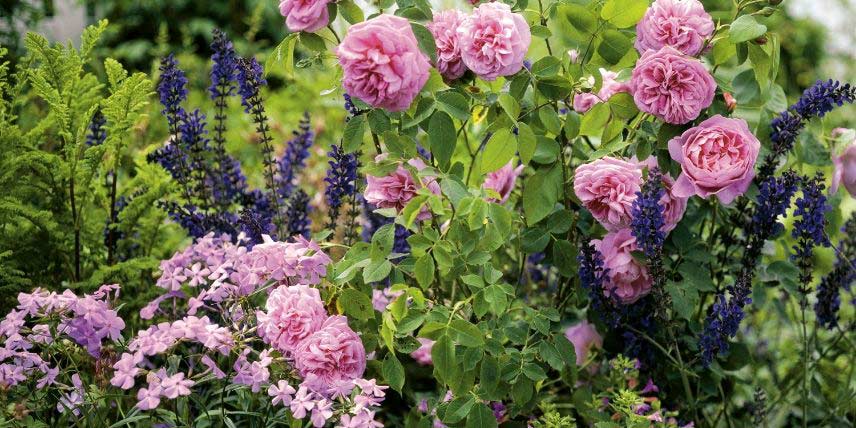
Rose ‘Gertrude Jekyll’, Salvia nemorosa and Phlox carolina ‘Bill Baker’ (photo Friedrich Strauss – MAP)
Read also
Sages: which varieties to choose?To create a grey or silver garden
You can use sages to create a very original planting bed in silvery colour. Choose Salvia argentea, which offers large, grey, downy foliage. You can pair it with Centaurea ragusina, artemisia ‘Powis Castle’, Senecio cineraria, as well as Helichrysums or Santolinas.
We also recommend favouring plants with soft, downy texture! For example, include Stachys lanata, grass Lagurus ovatus and Verbascum ‘Polarsommer’… You will achieve a very original, elegant and timeless effect!
It would be visually striking to contrast the bed and highlight these silvery tones by planting a few dark-foliaged plants on the edge, such as Ophiopogon planiscapus ‘Nigrescens’ or Heuchera ‘Obsidian’.
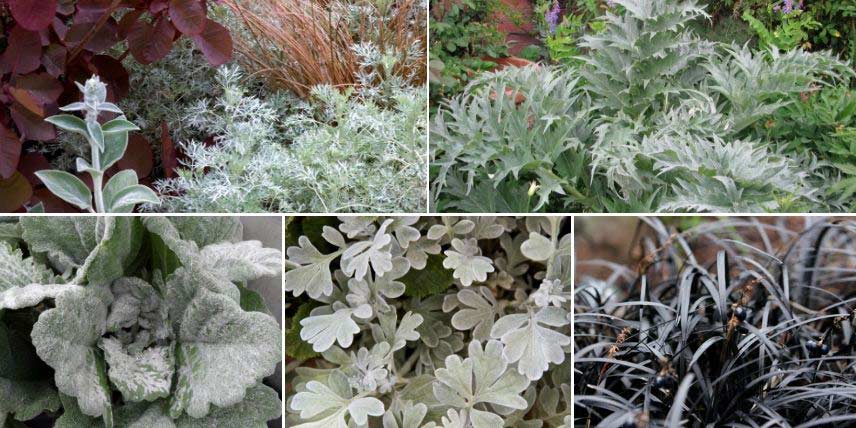
Scene with Stachys byzantina, Cotinus ‘Grace’ and Artemisia ‘Powis Castle’ (photo Liz Eddison – Flora Press – Biosphoto) / Cynara cardunculus / Salvia argentea ‘Artemis’ / Artemisia stelleriana ‘Boughton Silver’ (photo P Laughton) / Ophiopogon planiscapus ‘Nigrescens’ (photo brewbooks)
In an exotic border of warm hues!
For an exotic, colourful border, enjoy the brilliant flowering of pineapple sage, Salvia elegans ! Pair it with crocosmias, Cannas, Kniphofias, Zinnias, Coreopsis… Also enjoy the colourful flowering of Dahlias. If you live in an area with a mild climate, you can include Hedychiums. Enjoy ornamental grasses with colourful foliage such as Pennisetum setaceum ‘Rubrum’ and Imperata cylindrica ‘Red Baron’! Ideally, at the back of the border, plant hardy bananas (Musa basjoo), palms (Chamaerops or Trachycarpus), bamboos and Colocasias…
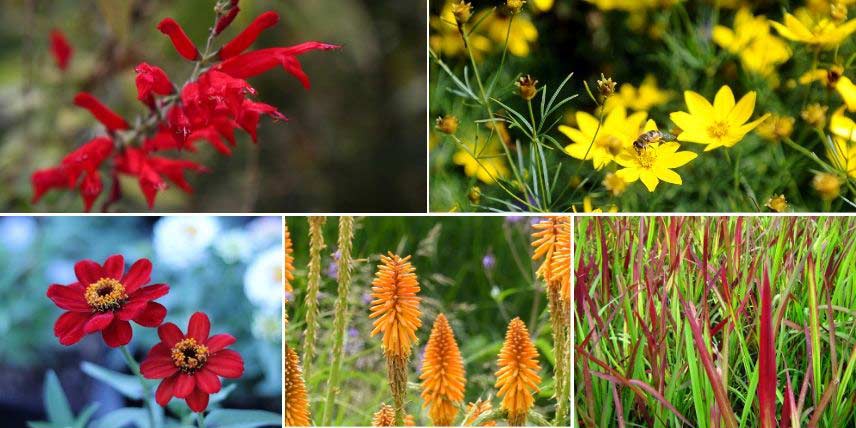
Salvia elegans ‘Pineapple’ (photo Maja Dumat) / Coreopsis verticillata (photo Niccolò Caranti) / Zinnia ‘Profusion Red’ (photo S.G.S.) / Kniphofia ‘Fiery Fred’ / Imperata cylindrica ‘Red Baron’
In a cottage garden
With their airy flowering and often blue, violet or white shades, salvias can easily be incorporated into an English cottage garden. We recommend for this Salvia farinacea. To accompany it, favour flowering in soft shades: blue, mauve, pink, white… For example, enjoy clematis, trained up a house façade or on a pergola, as well as foxgloves, delphiniums, astrantias, and the superb Campanula persicifolia. Also enjoy blue or white flowering of Agapanthus. Add decorative foliage, such as ferns, hostas and heucheras! Don’t forget alchemilla foliage. You will create a lush border with a sense of abundant planting.
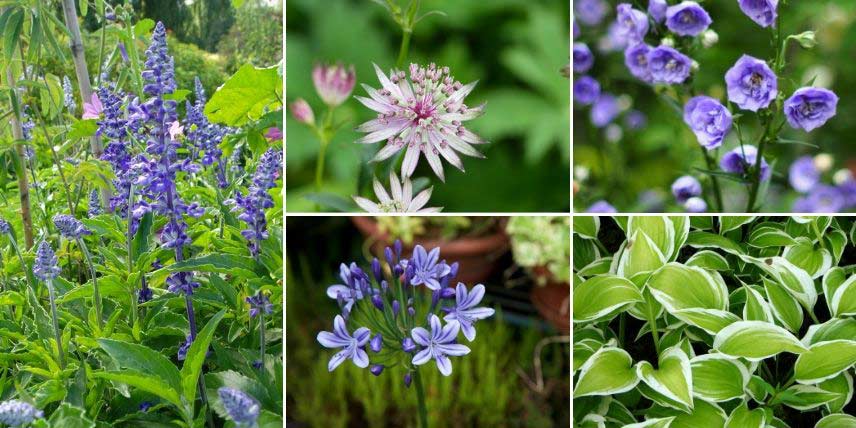
Salvia farinacea (photo Udo Schröter) / Astrantia major ‘Ruby Star’ / Campanula persicifolia ‘La Belle’ (photo M’s photography) / Agapanthus / Hosta ‘Emily Dickinson’
In a mixed border, alongside other perennials with colourful flowering displays!
You can also use salvias to create a border planted with perennials with very colourful flowering. Choose, for example, Salvia nemorosa or Salvia verticillata. Pair them with the superb flowers of Leucanthemum, Achillea, Zinnia, Echinacea, Delphinium, Dahlia… For lightness and elegance of their flowering, add Cosmos. To bring volume and movement, consider ornamental grasses, such as Pennisetum, Miscanthus or Stipa. Also choose Nepetas and Perovskia, whose flowering will somewhat recall that of salvia.
You can also use red-flowering salvias, Salvia microphylla or Salvia elegans, to bring dynamism to the border!
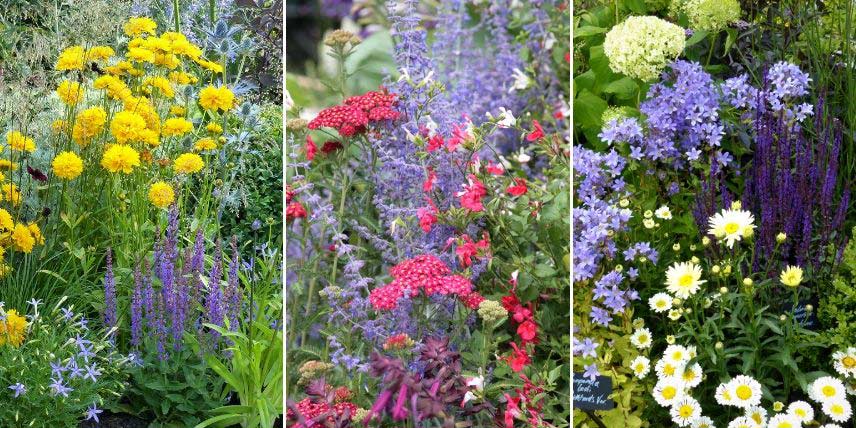
Coreopsis ‘Early Sunrise’, Salvia nemorosa ‘Blauhugel’ and Laurentia / Achillea ‘Red Velvet’, Salvia microphylla ‘Hot Lips’ and Perovskia / Salvia nemorosa ‘Caradonna’, Campanula lactiflora ‘Prichard’s Variety’ and Leucanthemum ‘Banana Cream’
- Subscribe!
- Contents
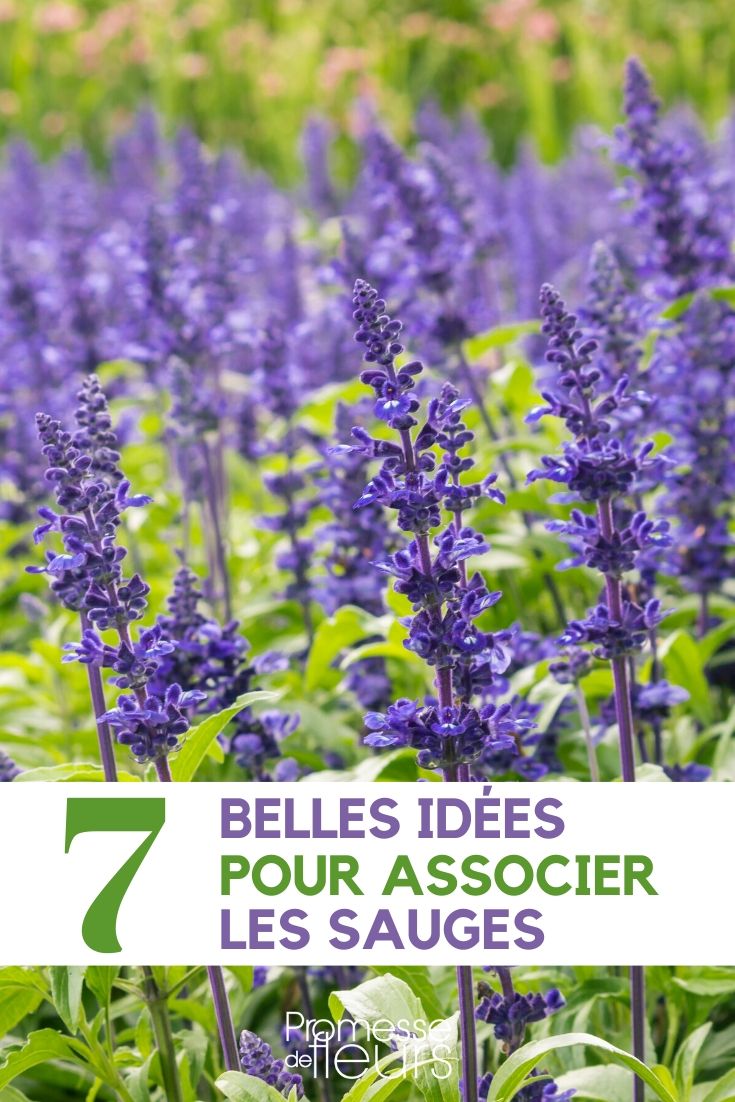































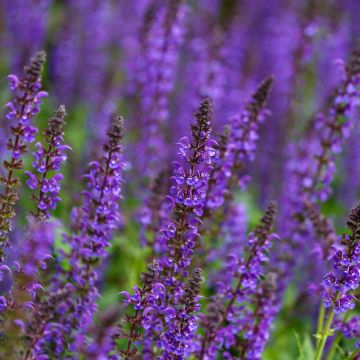
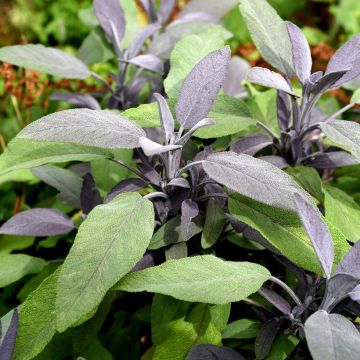
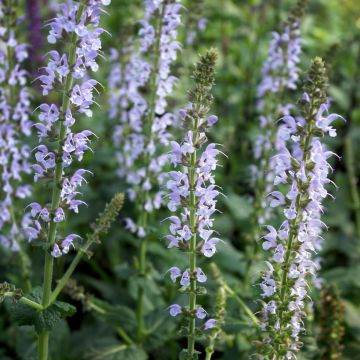
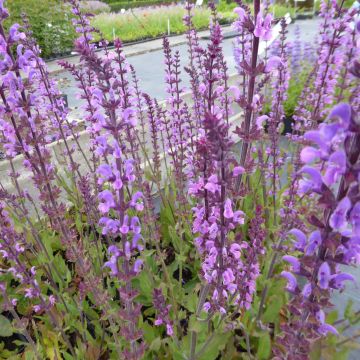
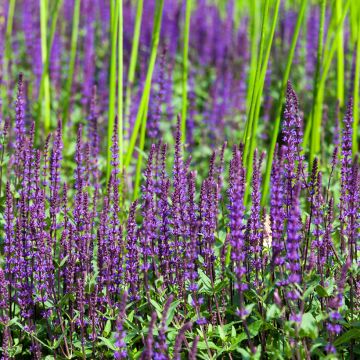
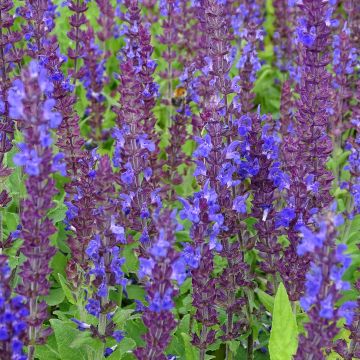
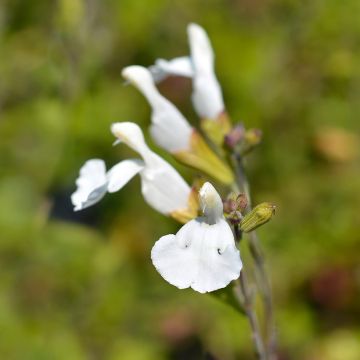
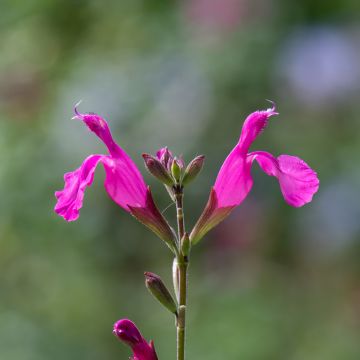
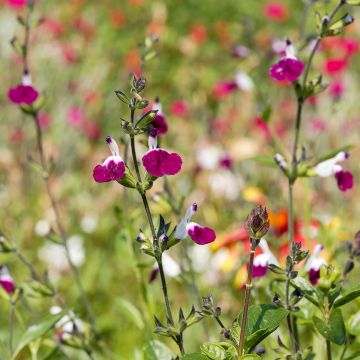
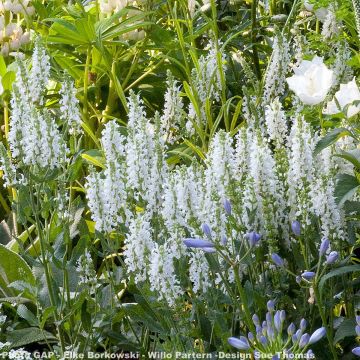
Comments